If embodied information is not present in written communication, we might ask, where is it located? In future research, we must describe those sources of information outside of texts—such as gesture—where experts represent sensory information not articulated in written texts and procedures. (Sauer, 1998, p. 161)
DESIGNING A FIELD STUDY: CHALLENGES AND LIMITATIONS
Offering a detailed account of all the methodological variables I had to negotiate in this project is beyond the scope of this webtext. However, one important insight that I've garnered through the process of designing visualizations of firefighters' literacy practices is that data visualizations not only reflect the data set, but also reveal methodological assumptions and limitations. When a researcher considers whether to collect visual data, they are making a methodological decision that will impact their research design. When a researcher decides where to point a camera, they are making a methodological decision about which moments are worth observing. When a researcher begins transcribing raw data from audio transcripts into a text-based representation, they are making methodological decisions by filtering certain sounds, statements, and voices. When a researcher selects a 2-minute video clip or organizes data into a table, they are making methodological choices about which data an audience will see. Each of these decisions impacts which phenomena or elements of practice are emphasized within articles, monographs, and webtexts.
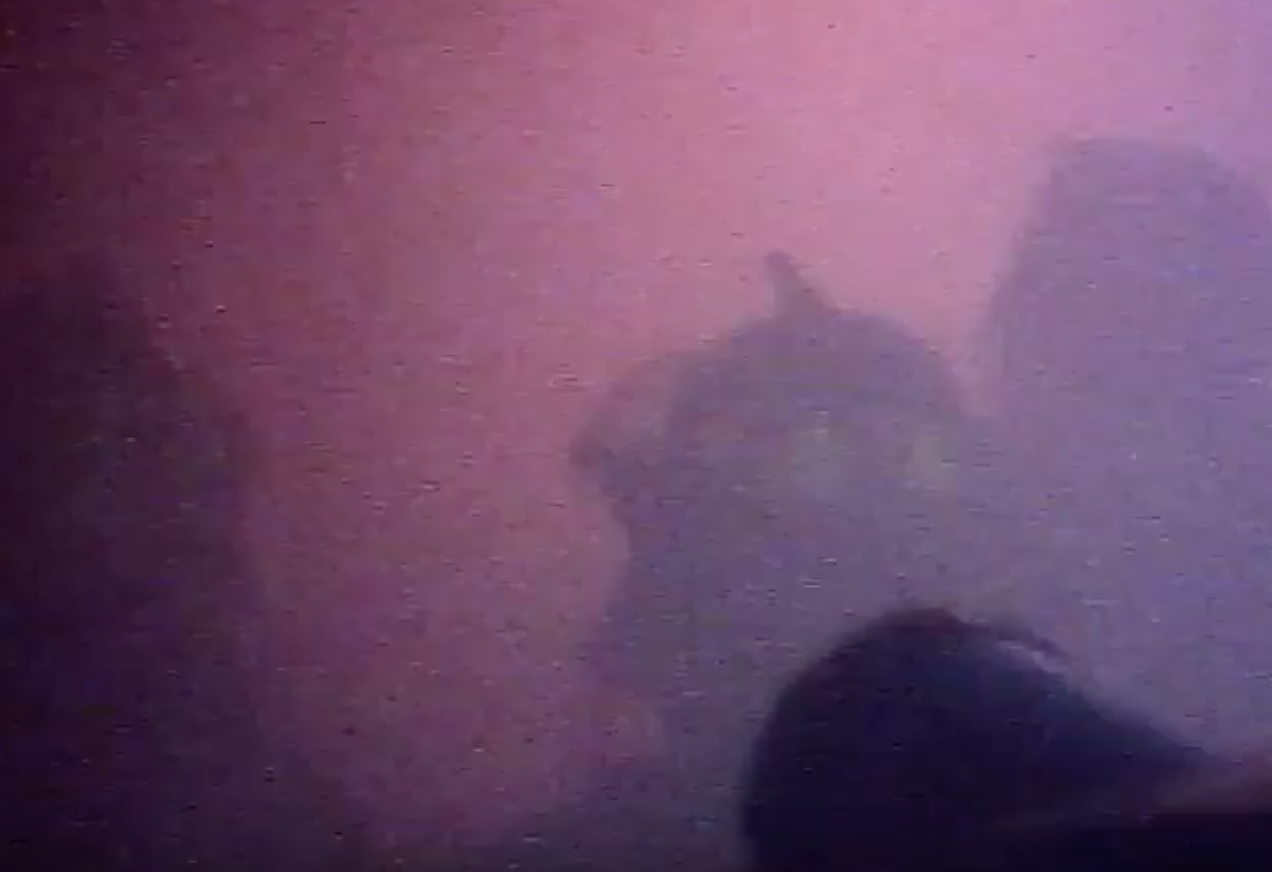
Thus, one designerly choice that I've made has been to present data excerpts that illuminate the important role literacies occupy within firefighting activities alongside of the network visualizations that appear in the next section. It is my hope that these images, video, audio and interview transcripts, and tables work to complicate what it might mean to visualize data, as these data also serve as visualizations. Each piece of data presented on this page works to illustrate an aspect of firefighter practice in a way that another selection could not. For example, without access to a thermal imaging camera (TIC), I would not have been able to show how heat influences firefighters' work. Still, what it most important about these data is that they illustrate the potential digital tools have to open new opportunities for workplace literacy and technical communication research in hazardous work environments. Historically, research in these contexts has relied upon methods for collecting data removed from the actual site of practice. Sauer's (1994, 1998a, 1998b, 1999, 2003) studies of risk communication in the mining industry, for example, were predominately based on interviews and analysis of documents that reflected risk practices in the industry because these data could be safely gathered at a distance from actual hazard.
This study, too, reflects this limitation. Firefighters' literacy practices often unfold as fleeting, tacit, and/or embodied elements of larger operational activities within risk-laden environments like a structure fire. Traditional observational methods were poorly suited for capturing data about firefighters' situated literacy practices because smoke, darkness, loudness, heat, gear, and tools obfuscate their work. By using digital tools, I was able to successfully observe firefighters within a naturalistic live-fire environment similar to the risk-laden environments they encounter in the field. However, I also had rely on interviews with participants to get a sense of how such practices unfold during highly exigent emergency scenes. In this section, then, I briefly sketch some of the challenges and processes associated with gathering data about firefighters' workplace literacies, before discussing how I segmented and coded data to prepare for visualization and analysis.
GATHERING DATA
Ethnographers Bella Dicks, Bambo Soyinka, and Amanda Coffey (2006) argued that digital tools open up new potentials for ethnographic work, so I began adapting tools, methods, and practices from multimodal and digital ethnography to overcome the challenges distinct to the research site (Bezemer et al., 2012; Hurdley & Dicks, 2011; Kress, 2011; Murthy, 2008; Pink, 2011). Over a 2-year period, I performed six observations at the training facility and interviewed 16 firefighters of varying rank affiliated with the facility. With the help of leaders, instructors, and personnel at the site, I developed a number of techniques for gathering observational data from within the burn building. By locating digital audiorecorders outside of the structure or within the pockets of instructors' heat resistant coats, I was able to capture sound recordings of ambient work environments, firefighters' use of tools, and oral- and radio-based communications. Using a GoPro, I took still photographs of artifacts, practices, tools, and work environments, and/or positioned the camera in static locations to capture wide-view recordings of activities at the site. I also acquired two special heat-resistant cameras, which were mounted to firefighters' helmets or hand-tools. I found a specialized thermal imaging camera capable of broadcasting video in real-time to a receiver assembly, which I was able to screen-record on a laptop by splicing together a series of adapters. Below I've provided examples of these data types.
Audio Recordings
Audio Recording 1. An officer from an engine company issues a size up of a working fire during a training evolution. A size up is an important genre that a first-arriving unit will issue using radios to paint a picture of an incident scene that enables incoming units to plan. Audio Recording 1 transcript.
Audio Recording 2. The steady vibration of a self-contained breathing apparatus end-of-service-time-indicator, also known as a low-air alarm, can be heard in this recording. The alarm, which offers firefighters aural and haptic feedback through the SCBA regulator, activates automatically when firefighters reach 33% of air remaining in a cylinder. Audio Recording 2 transcript.
Photography
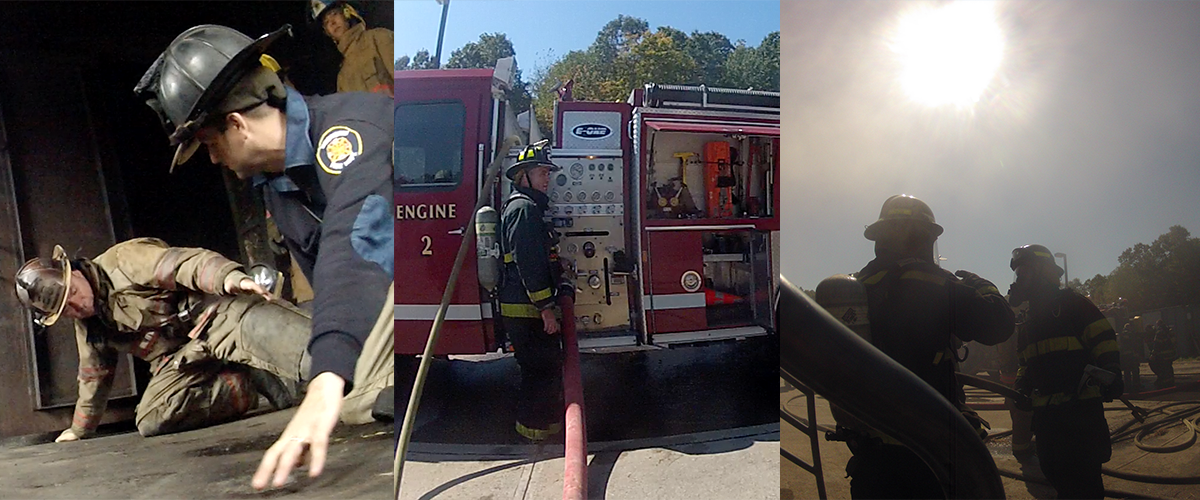
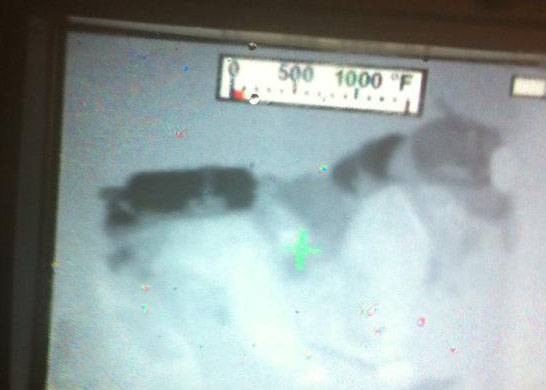
Video
Figure 10. Illustrates the type of videos that were captured using specialized heat resistance helmet cameras. The video is taken during a level one burn conducted at the training facility. During level one burns at this site, fire instructors discuss and show how fire behavior begins in an incipient stage, progresses through growth, reaches full involvement, and begins to decay. These burns also provide firefighters with experience learning what it feels like to be exposed to heat, and build confidence in the protective equipment that they wear. Figure 10 visual transcript.
Figure 11. Illustrates the type of wide-angle videos that I used to track how firefighters, crews, and practices unfolded at the training facility. The video illustrates how smoke can provide clues as to a fire's location, as well as demonstrates how engine and truck companies work in highly coordinated fashion to carryout distinct tasks. Figure 11 visual transcript.
Thermal Imaging
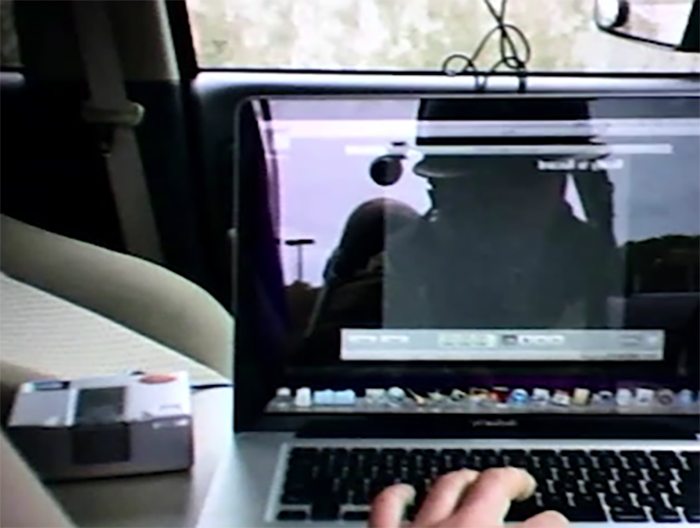
Figure 13. Illustrates the type of video recordings I was able to capture using the technique described in Figure 12. In this video, a crew uses a water can (extinguisher) to knock down the fire and then finishes suppressing the fire using a hoseline. Note that the white image of the platte burning begins to darken as water is applied, cooling the fire. Figure 13 visual transcript.
SEGMENTING AND ORGANIZING DATA
Once I had gathered a robust set of field data and interviews, I reviewed it while taking notes to identify segments that seemed fruitful for further deeper review. After I had viewed and listened to the entire corpus of raw data, I organized all the videos, audio recordings, photographs, and field notes that I had taken into folders. I transcribed all the interviews, but opted to take notes on the hundreds of observational data rather than immediately transcribe all of these video and audio recordings. After I reviewed the observational data, I began working with the set from Orderville Fire Department's Special Hazards Company drill because it was high quality, and the thermal imaging videos were among the best I had captured during my observational visits to the site. Moreover, members of the company had stayed after the drill to review footage and had identified a point in the evolution where a crew had kept stopping during a search. We were all curious why the crew kept stopping because the video didn't offer visual cues. Yet, the crew was stopping for extended periods of time while carrying out a primary search—which should have been rapidly conducted. (See Figure 15: Search Team Two, below, to observe this specific phenomena. In the upper right hand where the thermal imaging video is depicted in screen, you can see the crew immediately stops searching once the radio keys between 1:35–2:03. The team works as a group to piece together the radio message they heard, and to develop a message that contains the pertinent information for the IC). I was interested in seeing what I might learn by synching up the thermal imaging video with the wide angle shot and the audio from the session. Ultimately, I segmented data into an observational pool that included the video, audio, and images from Orderville and an interview pool of the 12 best interviews. (Interviews with four participants were conducted while they were on duty, so they were either cut short or had a level of ambient noise that made it difficult to transcribe them.) For the observational data, I built a number of photo arrays like Figures 8 and 14 that zoomed in on moments when firefighters' practices revealed that they were gathering information or communicating in some way. I synced the video from the Orderville drill and transcribed the audio. Thereafter, I began compiling moments where practices were clearly visible in a table.
Review Notes
8:17: Fire intensity growing; heat increasing; pressure building.
8:25: The smoke passing by the window is an indicator of the pressure in the space. The fire is drawing oxygen to it.
9:54: Instructor discusses importance of setting landmarks while navigating in low visibility.
9:59: Blackout/zero-visibility conditions.
10:27: Color of smoke is an indicator of conditions in fire. Black dark smoke indicates that atmosphere is becoming oxygen deficient.
16:18: Instructor stresses importance of staying in contact, using the hand-line effectively, knowing when and why to move up or stay back. States that firefighters must understanding the feeling of the hose. If the pressure decreases, it might be an indicator that the team has lost water. Notes that in order to communicate effectively in such loud environments, firefighters often have to face who they want to talk to and shout directionality.
Transcription of Interviews, Audio, and Video Data
We have an accountability system, so we know who's what and where. And usually the accountability system is for people inside the structure or inside the building whether it's a fire or it's a box alarm and people are going in. And, we have it's called an accountability system. I usually keep a yellow pad so I can write different things down. I'll grab who is inside on the first line, instead of looking at the tags I'll just scribble something down, where the line came from Engine 10's got that line you've got Engine 10's line, I'll write down the time they went in, I'll take a note of it I'll call dispatch tell them I have the first crew going in. A lot of times we go to the accident scene we need to know what time we get the patient extricated, I write that down in the yellow pad so I have it because I know they're [dispatch] not writing it down. And, a lot of vital information I'll write down. Plus, whatever I need to know quickly so that I don't have to think about it. I'll just look at my yellow pad. And, you learn quickly that pens don't write in the winter. [hearty laughs] So I carry a pencil. It gets tough in the rain writing anything in the rain or snow. So definitely different methods. One of my deputies now is carrying an iPad and he's basically learning how to use it; he's doing very good with it. He has a lot of pre-plans on it, a lot of diagrams of the buildings, and we're trying to refine it so that all the chiefs are carrying them.
— Chief Ron Burke, Interview
22:10–22:12: Lt. Lamb [radio transmission]: "Team two from command."
22:11: [The team comes to an abrupt stop.]
22:16–22:17: Ff. Ennis: [radio transmission; heavy feedback]: "Team two answering command"
22:17–22:19: Lt. Lamb [radio transmission]: "Be advised you have heavy smoke pushing out of the Bravo and Charlie side."
22:26: Ff. Larimore says something softly to Ff. Ennis.
22:27: Ff. Ennis: "What's that?"
22:28: Ff. Larimore [oral message, raises volume of voice]: "Let him know we got fire."
22:30–22:33: [radio transmission; heavy feedback]: "Command we have fire rolling in the B/C corner.
22:39: Ff. Ennis [oral message]: "Ok, guys."
22:40: Ff. Larimore [oral message]: "Let's go; let's go."
— Orderville Fire Department, Special Hazards 1, Audio-Video Observation
Photo Arrays
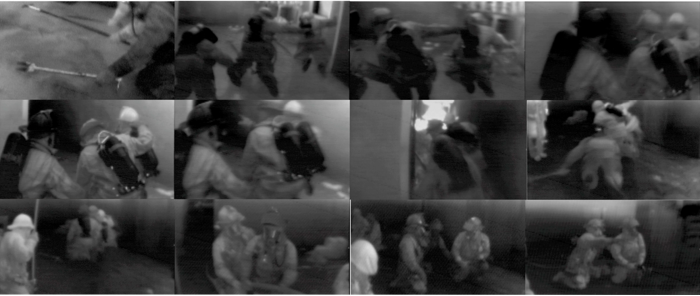
Synching Data Streams
Figure 15. Is an excerpt of a Special Hazards company performing a primary search on the first floor. Please take special note of the rich ambient sounds in the space. This data collection corresponds to the search described above where the crew abruptly stopped for an extended period of time during an primary search (1:35–2:03) as well as the photo array in Figure 14 (above). Figure 15 visual transcript.
Figure 16. Is an excerpt of a Special Hazards company continuing the search on the second floor of the training facility. It demonstrates how combining data streams offers a different view of practice than audio, video, or thermal imaging alone. One point worth paying special attention to is activity between 1:17–1:51, as the crew clears the room. The crew leader sends the crew into the room. They are now using a left-hand search pattern. The crew continues to wave tools across the floor to locate victims or objects, while the crew leader repeatedly strikes the floor with his axe serving as a secondary (aural) reference to help the crew orient within the space. Figure 16 visual transcript.
CODING DATA
After I had finished segmenting data into pools or sets that were manageable, I began the process of coding and analysis. To facilitate the coding process, I built tables that accounted for agents, artifacts, tools, genres, literacy practices, and objectives that were present in observational data or mentioned by interview participants (see Tables 1, 2, and 3 below). Once I had populated the tables, I accounted for the modal attributes that surrounded each data point. At this stage of the project, I used following codes to account for 12 modes: visual, alphanumeric, color, cognitive (frameworks or practices), oral, aural, radio, gestural, posture, tactile, kinesthetic, and spatiotemporal. As I further refined the data for visualization, I collapsed a number of these categories: for instance, I recoded gesture as kinesthetic-visual and radio as aural-oral. Table 1 illustrates the coding schema I developed to account for and code the relationships in multimodal literacy practices that existed within the dataset. Tables 2 and 3 are excerpts from the tabularized data from Chief Burke's interview and the Orderville observational data set.
Table 1. Coding Schema
| Coding Round | Coding Category | Categorical Definition | Example |
|---|---|---|---|
| Round One: Identify Practice & Code Function | Transactional or Communicative | Practices used predominately for interpersonal, communicative aims. | Size up issued by first arriving units to share information regarding status and emergency type. |
| Round One: Identify Practice & Code Function | Intra-personal or Mediational | Practices used predominately for intra-personal or mediational aims. | Firefighters' practices for reading smoke and fire behavior. |
| Round Two: Code for Modalities Present in Practice | Visual | Practices that make use of sight or vision. | Firefighters practices for reading smoke and fire behavior. |
| Round Two: Code for Modalities Present in Practice | Oral-Face-to-Face | Practices that include speaking and listening enacted in face-to-face settings. | Firefighters working as a team coordinate tasks using speech. |
| Round Two: Code for Modalities Present in Practice | Radio | Practices that make use of aural and speech broadcast over radio systems. | Size up broadcast over radio by first arriving unit to incoming units. |
| Round Two: Code for Modalities Present in Practice | Alphanumeric | Practices that make use alphabetic, text-based, numeric, or graphical information. | Gold-leafing on fire apparatus designates resource type and identification number (e.g., Engine 5 v. Ladder 3 v. Rescue 7). |
| Round Two: Code for Modalities Present in Practice | Aural | Practices that make use sound, pitch, tone, and noise | Chirp and alert sounds built into the Personal Alert Safety System (PASS) on Self Contained Breathing Apparatus (SCBA). |
| Round Two: Code for Modalities Present in Practice | Tactile | Practices that make use of touch, feel, force, pain, heat. | Firefighters tapping one another on the boot as they clear a room doing a search to communicate co-presence. |
| Round Two: Code for Modalities Present in Practice | Kinesthetic | Practices that make use of movement and gesture. | Forcefully hitting floors and/roofs with handtools to "sound" their structural integrity. |
| Round Two: Code for Modalities Present in Practice | Spatio-temporal | Practices that make use of space or time. | Using right or left hand search patterns to navigate structures. |
| Round Two: Code for Modalities Present in Practice | Cognitive | Heuristics, mental maps, and metacognitive elements of practice. | NUCAN is a mnemonic device that stands for Name, Unit, Conditions, Air, Needs. This is essential information a firefighter will communicate if they have to call a mayday report. |
Table 2. Data Points from Orderville Fire Department Training
| Genre | Duration | Agent | Tool/Media | Objective | Modal Attributes |
|---|---|---|---|---|---|
| warning labels | 00:10-03:10 | SCBA, PPE, helmet, apparatus | label | legal, safety, limitations | alpha-numeric, visual |
| group discussion | 00:10–00:12 | Team 2, Ff. Ennis, Ff. Linn, Ff. Larimore | body | plan/coordinate work (inferred) | oral, visual, gestural, alphanumeric, posture |
| radio mic key alert | 00:11–00:12 | Ff. Ennis | portable UHF radio | alert speaker mic is open | aural |
| radio message | 00:16–00:17 | Lt. Lamb | portable UHF radio | acknowledge team 2 message | aural, oral, alphanumeric |
| hand to outside wall | 00:26–00:57 | Ff. Ennis | body | navigation, location, construct mental map | cognitive, tactile, kinesthetic, spatio-temporal |
| hand to SCBA | 00:26–03:10 | Ff. Larimore | body | communicate presence, maintain team cohesion | tactile, kinesthetic |
| hand to boot | 00:26–03:10 | Ff. Linn | body | communicate presence, maintain team cohesion | tactile, kinesthetic |
| waving tools across floor | 00:28–00:57 | Team 2 | body-tool | construct mental map, check safety of floor, search for victims | tactile, kinesthetic, aural |
| observation | 00:34–01:23 | Lt. Brodrick | body | observe Team 2 search | visual, aural, posture |
| SCBA breathing inhale | 00:45–00:46 | Ff. Linn | body-scba | ambient sound | aural, tactile |
Table 3. Data Points from Chief Burke's Interview
| Genre | Duration | Agent | Tool/Media | Objective | Modal Attributes |
|---|---|---|---|---|---|
| 360 | n/a | Chief Burke | body | gather information, identify hazards, begin planning | visual, kinesthetic, aural |
| accountability board | n/a | Chief Burke | hooks, unit assignments, tags | track unit assignments, plan incident | visual, spatio-temporal, alpha-numeric |
| accountability board | n/a | Chief Burke | tags | track unit assignments, plan incident | visual, spatio-temporal, alpha-numeric |
| observe architectural features | n/a | Chief Burke | body | identify hazards, formulate plan | visual, spatio-temporal |
| envision floor plan | n/a | Chief Burke | body | construct mental map, identify hazards, formulate plan | cognitive, visual, spatio-temporal |
| assess building construction type | n/a | Chief Burke | body | identify hazards, formulate plan | visual, cognitive, spatio-temporal |
| monitor time | n/a | Chief Burke | watch | manage personnel, plan, evaluate risk | visual, alphanumeric, cognitive |
| issue evacuation order | n/a | Chief Burke | radio | order crews to exit building, safety | aural, oral, radio |
| evacuation air-horns | n/a | Driver-Operator | apparatus | provide aural signal that conditions unsafe, immediate exit | aural, tactile |
| iPad | n/a | Chief Burke's Deputy | iPad | manage incident, gather information, plan | visual, alphanumeric |
DATA OPS TAKEAWAYS
In this section, I've discussed how I adapted and deployed various tools and methods to collect data about firefighters' literacy practices. I have selected and presented excerpts that I believe show the potential that digital tools have for observationally following firefighters within hazardous environments where they practice literacy. I have also provided some insight into the processes I used to organize and segment data from a larger corpus, as well as how I analytically applied codes to the data. Taken together, the excerpts illustrate that data isn't neutral. Data is constructed through the choices we make as researchers regarding what data to collect, how to collect it (literally and figuratively pointing the camera), how we organize, filter, and segment data, and how to present and display data. Through all of these choices, we might illustrate and emphasize particular aspects of practice, while limiting other elements of practice that might have been apparent if we had utilized a different approach. It is my hope that this section demonstrates that the tools and methods I've experimented with might be adapted by researchers interested studying workplace literacy and risk communication practices in other contexts. It also seems prudent to note that as as researchers venture out into these contexts with new tools that they carefully weigh the considerable ethical and material risks associated with introducing digital research methods and tools within actual sites of work.